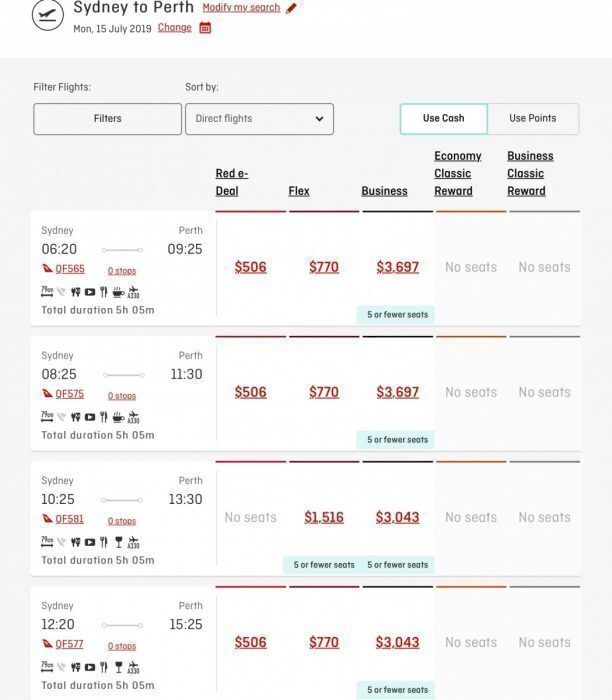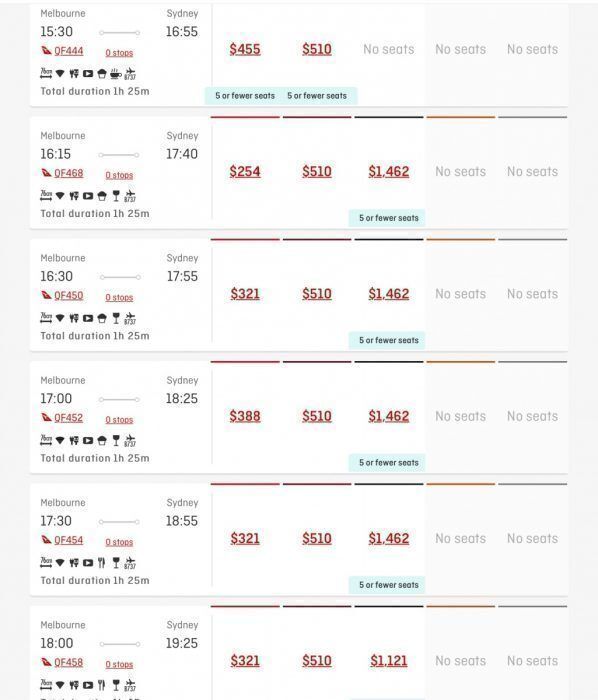In news that many might find hard to believe, business class airfares in Australia are falling, down 10.6% from July 2018. Australian Aviation is reporting the (Australian) Bureau of Infrastructure, Transport and Regional Economics (BITRE) results also indicated that July 2019 is the fourth consecutive month that business class airfares have fallen.
The result is compiled by tracking the cost of fares on the top 70 routes in Australia, collected from the websites of the two Australia airlines with business class cabins - Qantas and Virgin Australia. Fares include all taxes and charges and are adjusted for CPI movements.
The Australian quotes Westpac's Matthew Hassan, an economist, as saying the demand for premium seats is "restrained", and that,
"There has been a clampdown on discretionary spending … it may also be to do with corporates tightening up expense policies."
The May federal election in Australia was also a brake on business activity. The reasonably pro-business Coalition was unexpectedly returned, so you might have expected to see an uptick in business traffic and fares in June. But it was not the case.
What the airlines are saying
In May this year (before the election), Qantas reported a 2.3% improvement in revenue for the third quarter of the 2018/19 year. Qantas CEO Alan Joyce attributed this to a strong leisure market and a bounce-back in the Queensland and Western Australia resources sector. But he called out the softening corporate market. Alan Joyce said at the time,
"We'll have a better sense of how temporary this (softening) is after the federal election, which always has a dampening impact on travel demand,"
Virgin Australia reports much the same effect, saying market conditions were challenging as the airline struggled to woo corporate customers into its business class cabins. Virgin's CEO also suggested the May federal election put a damper on the usual post-Easter corporate travel bounce. Virgin Australia is under some pressure at the moment as it struggles to rein in costs.
After several years of very little price difference between Virgin Australia's business class and the Qantas premium cabin, a significant differential can be seen on some routes, Virgin often being less expensive. This is somewhat ironic, as most frequent flyers think that Virgin offers a better in-flight business class experience.
But what could be the real reason for the falling fares?
But the real reason for empty seats in the business class cabins of both airlines may not lie in market uncertainty or a need to cut costs. The real reason could be that domestic business class is not value for money. As one respondent to The Australian said,
"Demand hasn't dropped, the product is not worth the money - when will they (the airlines) learn?"
Meanwhile, a walk-up cash business class fare on Qantas between Sydney and Perth tomorrow will cost you a minimum of AUD$3,043. It is possible to fly business class to Europe for the same amount. One of those flights isn't even on an A330, rather the single-aisle 737.
This writer's last domestic business class flight, a rather lackluster affair on Qantas from Melbourne to Sydney paid for with points, was asking AUD$1,462 for the 90-minute flight. Not even a couple of rounds at Spice Temple in the domestic business class lounge in Melbourne and a glass or two of Vasse Felix will ease the sting of that fare. The business cabin was two thirds full.
A previous business class flight, on Virgin Australia between Gold Coast and Melbourne, filled five of the eight available seats. Virgin's cash fare on this route tomorrow starts from AUD$699. Qantas is asking AUD$1,037.
Business class fares are probably dropping because they've reached a price point where the market simply says "no." It's a basic function of weakening demand from a market that is justifiably questioning the appropriateness of forking out AUD$1,462 to fly up to Sydney.
Those passengers you do see in the domestic premium cabins usually either pay with points (like myself), travel at the expense of their employer, or have snared an upgrade.
Business class cabins won't be going anywhere for the foreseeable future. But as long as customers continue to resist paying the full price for them, BITRE's downward trend should keep continuing.
It might bring a bit of sanity back into the business class airfare price equation.






